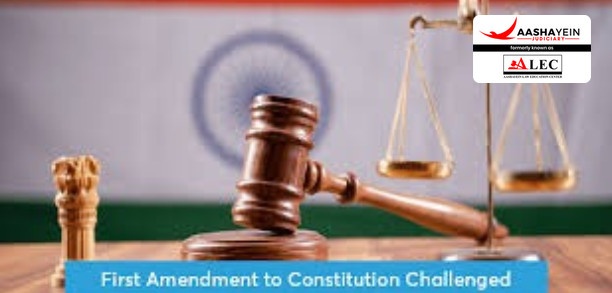Bench comprising Chief Justice Harilal J. Kania, Justice M. Patanjali Sastri, Justice Mehr Chand Mahajan, Justice Bijan Kumar Mukherjea, Justice Sudhi Ranjan Das.
This five-judge bench delivered a unanimous judgment, upholding the validity of the First Constitutional Amendment Act, 1951.
Background of the Case:
This case is one of the earliest landmark judgments related to the interpretation of the Indian Constitution. It primarily dealt with the constitutionality of the First Amendment Act, 1951, which introduced Article 31A and Article 31B, and created the Ninth Schedule to protect certain laws from judicial review. The petitioner challenged the amendment, arguing that it violated Article 13(2) of the Constitution, which prohibits the State from enacting laws that abridge fundamental rights.
Under Article 368, Parliament is empowered to amend the Constitution. However, the petitioner argued that the amendment process could not be used to abridge fundamental rights, as Article 13(2) prohibited any law from contravening them. This brought the scope of judicial review and the validity of shielding laws under the Ninth Schedule into question.
Facts:
The petitioner, Sri Sankara Prasad Singh Deo, challenged the constitutionality of the First Constitutional Amendment Act, 1951, focusing on its impact on the right to property under Article 19(1)(f) and Article 31. The amendment was introduced to facilitate agrarian reforms by ensuring that zamindari abolition and other land redistribution laws could not be challenged in courts. The petitioner argued that such an amendment violated the basic structure of the Constitution and was beyond the powers of Parliament under Article 368.
You can also read the Blog by visiting [Blog]
For more information, visit [Aashayein Enquiry Section]
Issues:
1. Whether the First Constitutional Amendment Act, 1951 violated Article 13(2) of the Constitution, which prohibits the State from making laws that infringe upon fundamental rights.
2. Whether Parliament had the authority under Article 368 to amend Fundamental Rights.
3. Whether the creation of the Ninth Schedule, which shielded specific laws from judicial review, was constitutionally valid.
Contentions of the Petitioner:
The petitioner argued that the First Constitutional Amendment Act, 1951, violated Article 13(2), which prohibits the State from making laws that abridge or take away fundamental rights. The petitioner contended that a constitutional amendment is a "law" under Article 13(2) and thus cannot curtail fundamental rights. The amendment, by introducing Articles 31A and 31B and the Ninth Schedule, directly infringed on the right to property under Articles 19(1)(f) and 31, effectively nullifying the protection provided to citizens by fundamental rights.The petitioner claimed that Article 368 does not grant Parliament the power to amend fundamental rights, arguing that these rights form the bedrock of the Constitution and are beyond the scope of amendment.
Contentions of the Respondent:
The respondent contended that a constitutional amendment under Article 368 is an exercise of constituent power, not legislative power. Therefore, it does not fall within the purview of Article 13(2) and cannot be invalidated for infringing fundamental rights. The respondent argued that Article 368 allows Parliament to amend any part of the Constitution, including fundamental rights, to ensure the Constitution's adaptability to changing social and economic needs. The government emphasized that the First Amendment aimed to address critical socio-economic issues, particularly land reforms and zamindari abolition, which were necessary for achieving distributive justice and fulfilling the Directive Principles of State Policy under Part IV of the Constitution.
Analysis of the Court
The Supreme Court upheld the validity of the First Constitutional Amendment Act, 1951, with ruling that Parliament has the power to amend any part of the Constitution, including Fundamental Rights, under Article 368. The Court interpreted Article 368 to allow Parliament to exercise constituent powers distinct from ordinary legislative powers. The amendment did not violate Article 13(2), as the Court held that a constitutional amendment is not considered "law" within the meaning of Article 13(2) and thus cannot be challenged on that basis. And the creation of the Ninth Schedule and protection of specific laws from judicial review was upheld. The Court noted that this was essential for implementing social and economic reforms, including zamindari abolition.
This ruling was later revisited in Golaknath v. State of Punjab (1967), where the Supreme Court limited Parliament's power to amend Fundamental Rights, and in Kesavananda Bharati v. State of Kerala (1973), which introduced the basic structure doctrine, effectively overruling the broad interpretation provided in this case.
Conclusion:
The judgment upheld the supremacy of Parliament’s power under Article 368. It also case marked the beginning of debates over the scope of judicial review, which became more refined in later cases like Indira Gandhi v. Raj Narain (1975), where the Ninth Schedule’s immunity was examined.
The decision laid the foundation for constitutional amendments and the balance of power between the legislature and the judiciary, highlighting the tension between individual rights and socio-economic reforms.

